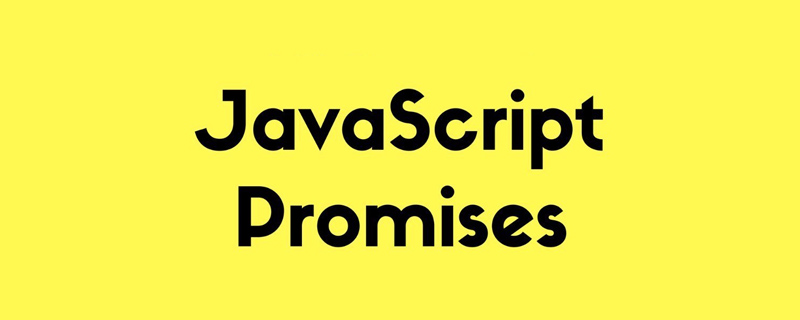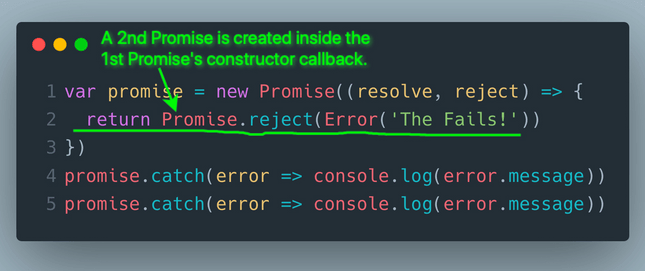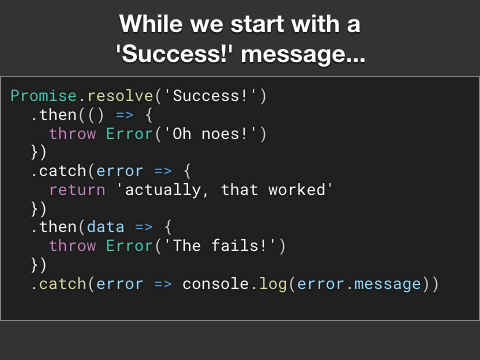Share 9 interview questions about JavaScript Promises

Please complete the following 9 questions
1. Multiple<span style="font-size: 18px;">.catch</span>
var p = new Promise((resolve, reject) => {
reject(Error('The Fails!'))
})
p.catch(error => console.log(error.message))
p.catch(error => console.log(error.message))What will be the output of the above code? Please choose the correct answer:
- [ ] Print the message once
- [x] Print the message twice
- [ ]
UnhandledPromiseRejectionWarning - [ ] Program exit
Analysis:
We use the constructor method to create a Promise and pass the reject callback The error is triggered immediately.
Then .catch works similar to DOM's .addEventListener(event, callback) or Event Emitter's .on(event, callback), where can add multiple callbacks. Each is called with the same parameters.
2. Multiple .catch##
var p = new Promise((resolve, reject) => {
return Promise.reject(Error('The Fails!'))
})
p.catch(error => console.log(error.message))
p.catch(error => console.log(error.message))- [ ] Print the message once
- [ ] Print the message twice
- [x]
- UnhandledPromiseRejectionWarning
Analysis:

resolve() or reject() callback. The Promise constructor does not use your return value, so no other Promises created by Promise.reject() will actually be received.
.catch after Promise.reject(), the answer is UnhandledPromiseRejectionWarning.
3. Link .then and .catch
var p = new Promise((resolve, reject) => {
reject(Error('The Fails!'))
})
.catch(error => console.log(error))
.then(error => console.log(error))- [x] prints an error and
- undefined
- [ ]
- UnhandledPromiseRejectionWarning
- undefined
Parsing

.then and .catch, it's helpful to think of them as a series of steps. Each .then receives as its argument the value returned by the previous .then. However, if your "step" encounters an error, any subsequent .then "steps" will be skipped until .catch is encountered. If you want to override an error, all you have to do is return a non-error value. Can be accessed via any subsequent .then.
Tip: console.log() always returns undefined.
4. Link.catch##var p = new Promise((resolve, reject) => {
reject(Error('The Fails!'))
})
.catch(error => console.log(error.message))
.catch(error => console.log(error.message))
- [ ] Print the error message twice
- [ ] UnhandledPromiseRejectionWarning
- [ ] Program exit
When chaining
.catch, each only processes the previous .then or `.catch Error raised in "step". In this example, the first .catch returns console.log, which can only be achieved by adding .then() after the two .catch Come visit.
5. Multiple .catch##new Promise((resolve, reject) => {
resolve('Success!')
})
.then(() => {
throw Error('Oh noes!')
})
.catch(error => {
return "actually, that worked"
})
.catch(error => console.log(error.message))
[ ] Print the message once
- [ ] Print the message twice
- [ ] UnhandledPromiseRejectionWarning
- [x] Print nothing
- Parsing
Tip:
.catch can be done simply by returning a regular value to ignore (or override) errors. This trick only works when subsequent .then
.thenPromise.resolve('Success!')
.then(data => {
return data.toUpperCase()
})
.then(data => {
console.log(data)
})
[ ] print "Success!" and "SUCCESS!"
- [ ] print "Success!"
- [x] print "SUCCESS!"
- [ ] Does not print anything
- Parsing
Tips: .then passes the data in sequence, starting from return value
to the next .then(value => /* handle value */). In order to pass the value to the next .then
return is the key.
.thenPromise.resolve('Success!')
.then(data => {
return data.toUpperCase()
})
.then(data => {
console.log(data)
return data
})
.then(console.log)
- [ ] 打印 "SUCCESS!"
- [ ] 打印 "Success!"
- [x] 打印 "SUCCESS!" 和 "SUCCESS!"
- [ ] 不打印任何内容
解析:
有两个 console.log 调用将被调用。
8. .then 之间的流程
Promise.resolve('Success!')
.then(data => {
data.toUpperCase()
})
.then(data => {
console.log(data)
})以上代码的输出将会是什么?请选择正确的答案:
- [ ] 打印 "SUCCESS!"
- [ ] 打印 "Success!"
- [ ] 打印 "SUCCESS!" 和 "SUCCESS!"
- [x] 打印
undefined
解析:
提示:.then 依次传递数据,从返回值到下一个 .then(value => /* handle value */)。
为了将值传递给下一个 .then,return 是关键。
9. .then 和 .catch 之间的流程
Promise.resolve('Success!')
.then(() => {
throw Error('Oh noes!')
})
.catch(error => {
return 'actually, that worked'
})
.then(data => {
throw Error('The fails!')
})
.catch(error => console.log(error.message))以上代码的输出将会是什么?请选择正确的答案:
- [ ] 打印 "Oh noes!" 和 "The fails!"
- [ ] 打印 "Oh noes!"”
- [x] 打印 "The fails!"
- [ ] 打印 "actually, that worked"
- [ ] 不打印任何内容
解析:

本文转载自:https://segmentfault.com/a/1190000021255822
英文原文地址: https://danlevy.net/javascript-promises-quiz/
相关教程推荐:JavaScript视频教程
The above is the detailed content of Share 9 interview questions about JavaScript Promises. For more information, please follow other related articles on the PHP Chinese website!

Hot AI Tools

Undresser.AI Undress
AI-powered app for creating realistic nude photos

AI Clothes Remover
Online AI tool for removing clothes from photos.

Undress AI Tool
Undress images for free

Clothoff.io
AI clothes remover

Video Face Swap
Swap faces in any video effortlessly with our completely free AI face swap tool!

Hot Article

Hot Tools

Notepad++7.3.1
Easy-to-use and free code editor

SublimeText3 Chinese version
Chinese version, very easy to use

Zend Studio 13.0.1
Powerful PHP integrated development environment

Dreamweaver CS6
Visual web development tools

SublimeText3 Mac version
God-level code editing software (SublimeText3)

Hot Topics
 How to implement an online speech recognition system using WebSocket and JavaScript
Dec 17, 2023 pm 02:54 PM
How to implement an online speech recognition system using WebSocket and JavaScript
Dec 17, 2023 pm 02:54 PM
How to use WebSocket and JavaScript to implement an online speech recognition system Introduction: With the continuous development of technology, speech recognition technology has become an important part of the field of artificial intelligence. The online speech recognition system based on WebSocket and JavaScript has the characteristics of low latency, real-time and cross-platform, and has become a widely used solution. This article will introduce how to use WebSocket and JavaScript to implement an online speech recognition system.
 WebSocket and JavaScript: key technologies for implementing real-time monitoring systems
Dec 17, 2023 pm 05:30 PM
WebSocket and JavaScript: key technologies for implementing real-time monitoring systems
Dec 17, 2023 pm 05:30 PM
WebSocket and JavaScript: Key technologies for realizing real-time monitoring systems Introduction: With the rapid development of Internet technology, real-time monitoring systems have been widely used in various fields. One of the key technologies to achieve real-time monitoring is the combination of WebSocket and JavaScript. This article will introduce the application of WebSocket and JavaScript in real-time monitoring systems, give code examples, and explain their implementation principles in detail. 1. WebSocket technology
 How to use JavaScript and WebSocket to implement a real-time online ordering system
Dec 17, 2023 pm 12:09 PM
How to use JavaScript and WebSocket to implement a real-time online ordering system
Dec 17, 2023 pm 12:09 PM
Introduction to how to use JavaScript and WebSocket to implement a real-time online ordering system: With the popularity of the Internet and the advancement of technology, more and more restaurants have begun to provide online ordering services. In order to implement a real-time online ordering system, we can use JavaScript and WebSocket technology. WebSocket is a full-duplex communication protocol based on the TCP protocol, which can realize real-time two-way communication between the client and the server. In the real-time online ordering system, when the user selects dishes and places an order
 How to implement an online reservation system using WebSocket and JavaScript
Dec 17, 2023 am 09:39 AM
How to implement an online reservation system using WebSocket and JavaScript
Dec 17, 2023 am 09:39 AM
How to use WebSocket and JavaScript to implement an online reservation system. In today's digital era, more and more businesses and services need to provide online reservation functions. It is crucial to implement an efficient and real-time online reservation system. This article will introduce how to use WebSocket and JavaScript to implement an online reservation system, and provide specific code examples. 1. What is WebSocket? WebSocket is a full-duplex method on a single TCP connection.
 JavaScript and WebSocket: Building an efficient real-time weather forecasting system
Dec 17, 2023 pm 05:13 PM
JavaScript and WebSocket: Building an efficient real-time weather forecasting system
Dec 17, 2023 pm 05:13 PM
JavaScript and WebSocket: Building an efficient real-time weather forecast system Introduction: Today, the accuracy of weather forecasts is of great significance to daily life and decision-making. As technology develops, we can provide more accurate and reliable weather forecasts by obtaining weather data in real time. In this article, we will learn how to use JavaScript and WebSocket technology to build an efficient real-time weather forecast system. This article will demonstrate the implementation process through specific code examples. We
 Simple JavaScript Tutorial: How to Get HTTP Status Code
Jan 05, 2024 pm 06:08 PM
Simple JavaScript Tutorial: How to Get HTTP Status Code
Jan 05, 2024 pm 06:08 PM
JavaScript tutorial: How to get HTTP status code, specific code examples are required. Preface: In web development, data interaction with the server is often involved. When communicating with the server, we often need to obtain the returned HTTP status code to determine whether the operation is successful, and perform corresponding processing based on different status codes. This article will teach you how to use JavaScript to obtain HTTP status codes and provide some practical code examples. Using XMLHttpRequest
 How to use insertBefore in javascript
Nov 24, 2023 am 11:56 AM
How to use insertBefore in javascript
Nov 24, 2023 am 11:56 AM
Usage: In JavaScript, the insertBefore() method is used to insert a new node in the DOM tree. This method requires two parameters: the new node to be inserted and the reference node (that is, the node where the new node will be inserted).
 JavaScript and WebSocket: Building an efficient real-time image processing system
Dec 17, 2023 am 08:41 AM
JavaScript and WebSocket: Building an efficient real-time image processing system
Dec 17, 2023 am 08:41 AM
JavaScript is a programming language widely used in web development, while WebSocket is a network protocol used for real-time communication. Combining the powerful functions of the two, we can create an efficient real-time image processing system. This article will introduce how to implement this system using JavaScript and WebSocket, and provide specific code examples. First, we need to clarify the requirements and goals of the real-time image processing system. Suppose we have a camera device that can collect real-time image data






